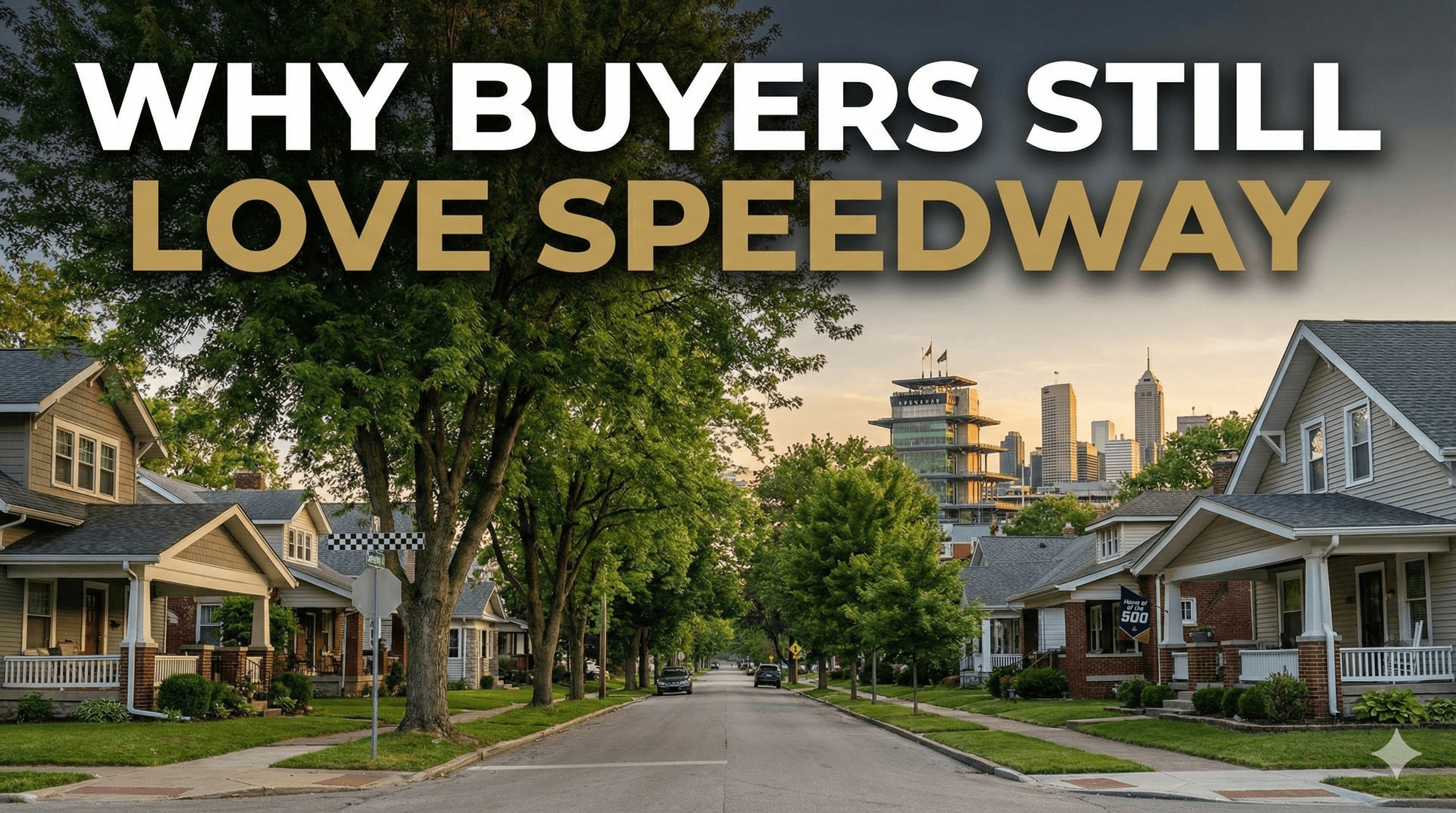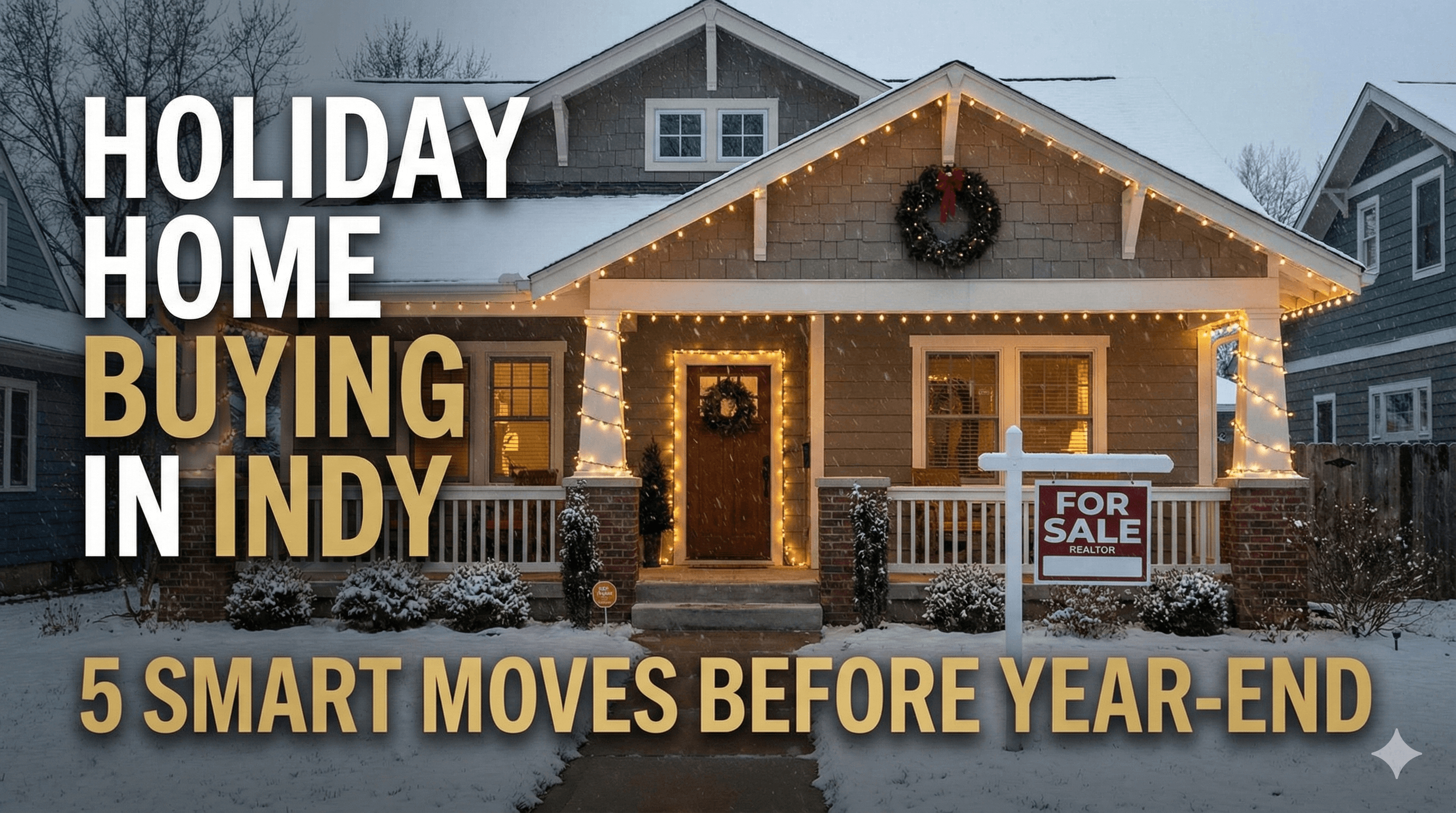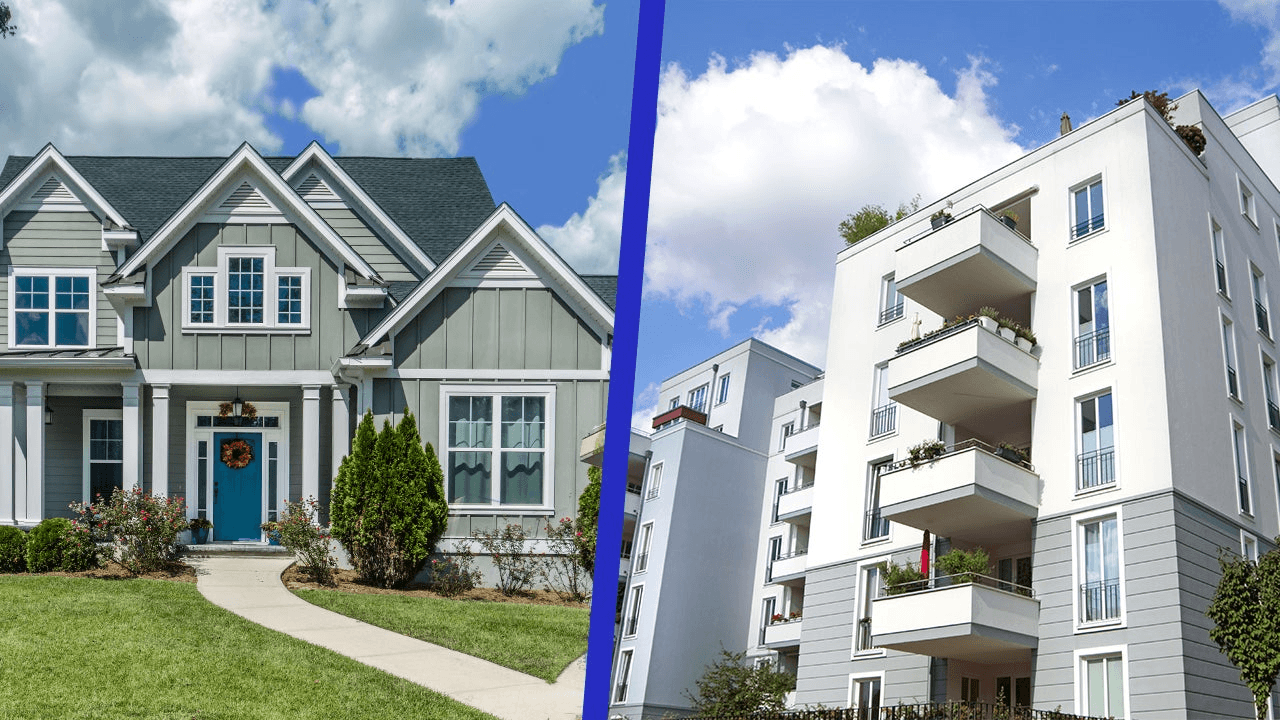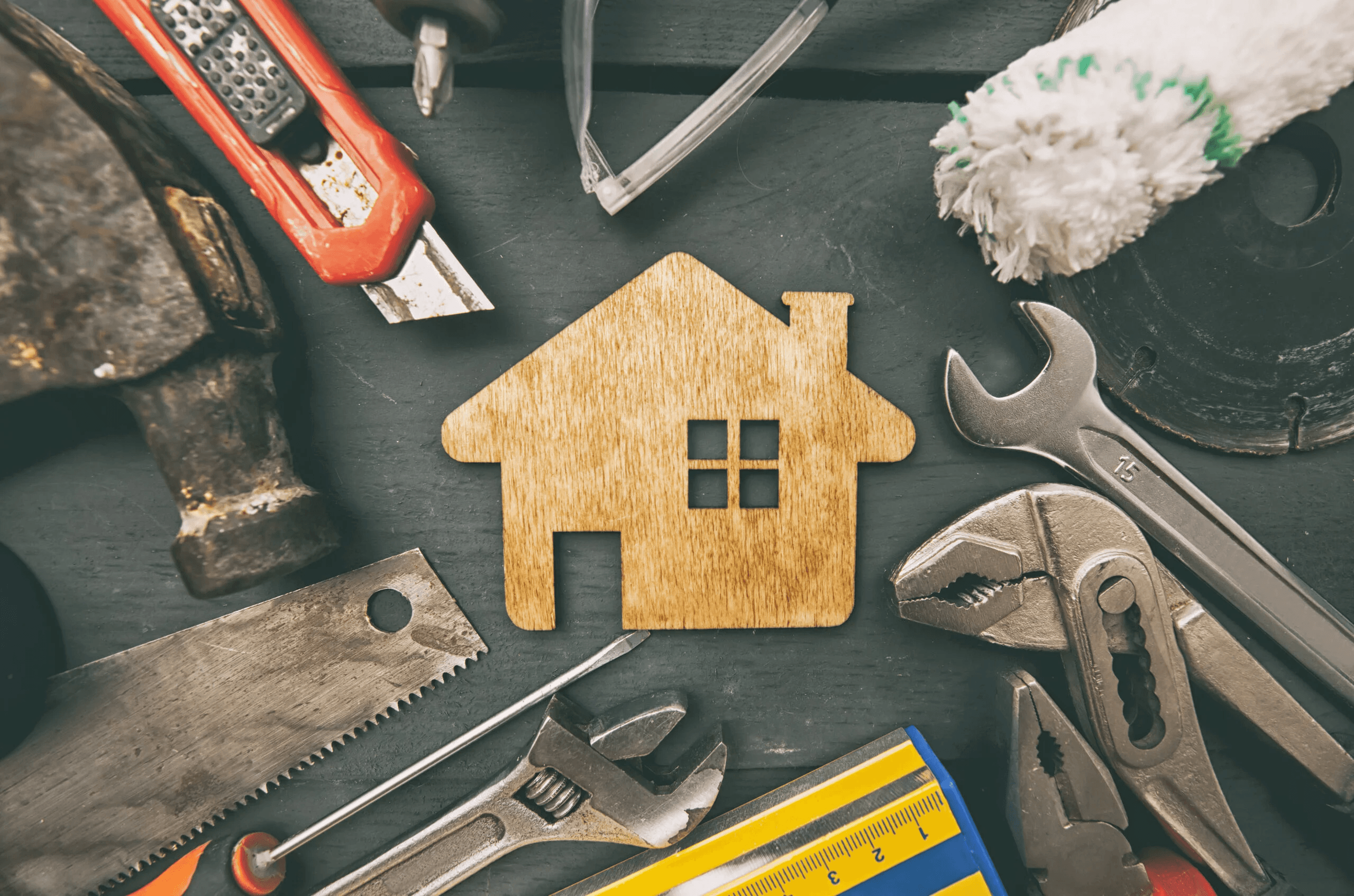Carmel, Indiana, has long been known for its top schools and family-friendly atmosphere — but over the past decade, it’s also become one of the most attractive real estate investment markets in the entire Midwest.
In 2025, investors are eyeing Carmel for its consistent appreciation, strong rental demand, and rock-solid economy. Whether you’re considering your first Indianapolis-area property or expanding your portfolio, Carmel offers a unique balance of luxury, stability, and long-term ROI.
Why Carmel Is an Investor Magnet in 2025
Carmel consistently ranks as one of America’s best suburbs to live in — and that reputation directly supports property values.
According to Redfin and Realtor.com (Q3 2025):
Median home price: ~$525,000 (up 3.4% year-over-year)
Median rent: ~$2,200/month (up 4.1% from 2024)
Vacancy rate: just 3.9%, among the lowest in the Indy metro
Population growth: +7% since 2020
Average household income: $140,000+
With its strong schools, booming corporate presence, and limited new land for development, Carmel maintains steady appreciation and reliable rental performance — even as other suburban markets fluctuate.
Types of Investment Opportunities in Carmel
Carmel isn’t just for owner-occupants anymore. Investors have found creative ways to tap into this high-demand suburb.
1. Long-Term Single-Family Rentals
The bread and butter of Carmel investing.
Ideal for families who want award-winning schools without buying.
Properties in neighborhoods like West Clay, Village Green, and Cool Creek rent easily with long-term tenants.
Average monthly rent: $2,000–$2,400
Expect 6–7% gross yields and near-zero vacancy in these neighborhoods.
2. Luxury Executive Rentals
Carmel’s growing corporate base (Allison Transmission, KAR Global, Ascension, IU Health) fuels demand for shorter-term executive rentals.
Think 3–12 month leases for relocating professionals.
Homes near the US-31 corridor and Carmel City Center perform best.
Furnished units command 15–20% premium rents.
3. Buy-and-Hold Appreciation Plays
Land and luxury home values continue to appreciate steadily.
New construction in West Carmel often appreciates 4–5% annually.
Properties purchased in the mid-$500Ks often reach $650K+ within 3–4 years.
If you’re holding long-term, Carmel provides appreciation consistency with low volatility.
4. Small Multifamily or Townhome Investments
While limited, some small-townhome or duplex opportunities exist closer to the Old Town Carmel corridor.
Great for “house hacking” or small-scale portfolio growth.
Typically priced $350K–$450K with $1,800–$2,200 rent potential per unit.
Why Carmel’s Market Performs So Steadily
Carmel’s fundamentals are nearly recession-proof thanks to its job diversity, top-tier schools, and infrastructure investment.
Key economic drivers:
Headquarters for major corporations (CNO Financial, Delta Faucet, Allegion).
Part of the “Silicon Prairie” tech corridor alongside Fishers.
Strong public investment in roads, green spaces, and arts districts.
Translation: Even when national markets wobble, Carmel stays steady — which is why it’s a core hold for many seasoned Indy investors.
Carmel vs. Other Indy Suburbs (2025 Snapshot)
Suburb | Median Home Price | Median Rent | Vacancy Rate | Appreciation (YoY) | Investor ROI Outlook |
|---|---|---|---|---|---|
Carmel | $525K | $2,200 | 3.9% | +3.4% | ⭐⭐⭐⭐ |
Fishers | $460K | $2,000 | 4.3% | +3.1% | ⭐⭐⭐⭐ |
Westfield | $445K | $1,950 | 4.6% | +3.7% | ⭐⭐⭐ |
Zionsville | $610K | $2,400 | 4.0% | +2.8% | ⭐⭐⭐ |
Greenwood | $330K | $1,600 | 5.5% | +3.2% | ⭐⭐⭐ |
Carmel sits in the “sweet spot” of ROI and risk: slightly pricier, but unmatched for tenant quality and long-term appreciation.
Investor ROI Breakdown: What to Expect in 2025
Carmel isn’t where you chase 12% cash-on-cash returns — it’s where you protect and steadily grow capital.
Typical investor metrics:
Cap rates: 5–6% (strong for an upscale market)
Cash-on-cash returns: 6–8%
Annual appreciation: 3–4%
5-year ROI: 30–40% (assuming rent growth + appreciation)
Carmel performs best as a buy-and-hold or BRRRR market for investors focused on quality tenants and long-term stability.
For a full metro overview, read: Indianapolis Rental Market 2025: Trends in Rents and Vacancies.
Top Neighborhoods in Carmel for Investors
1. Village of West Clay
Master-planned luxury community with new construction and consistent appreciation. Homes rarely sit vacant.
2. Old Town Carmel
Walkable, charming, and close to the Arts & Design District. Great for executive rentals and mixed-use investments.
3. Cool Creek North & Brookshire
Established neighborhoods with strong school zoning and affordable entry points under $450K.
4. Legacy and The Woods at Lion’s Creek
Newer developments with high-end amenities and resale upside.
Key Considerations Before Investing in Carmel
Upfront Costs Are Higher
Entry prices are steeper than downtown Indy or Speedway — expect $450K+ for quality investment properties.Lower Short-Term Yields, Higher Long-Term Stability
Carmel trades cash flow for appreciation and tenant quality — ideal for patient investors.Zoning & HOA Rules
Many subdivisions restrict short-term rentals, so stick to long-term or corporate leases.Property Taxes
Hamilton County taxes are moderate but vary — plan around 1.1–1.3% of assessed value.
Investor FAQs About Carmel Real Estate
Is Carmel too expensive for investors?
Not if you’re focused on stability and appreciation. You’ll pay more upfront but gain consistency and tenant longevity that balance out over time.
Do rentals perform well in Carmel?
Yes — particularly long-term rentals and executive housing. Vacancy is under 4%, and rent growth is steady.
What kind of ROI can I expect?
Average 6–8% cash-on-cash returns with 3–4% annual appreciation, depending on financing and property type.
Is Carmel good for BRRRR investing?
For high-end or long-term BRRRR models, yes — but you’ll need strong equity or renovations to justify the refinance.
See our deep dive: Top 5 Indy Neighborhoods for Investment 2025.
Final Thoughts: Carmel = Consistent, Safe, Long-Term ROI
If you’re looking for flashy cash flow, Carmel might not be your match. But if you want low vacancy, strong appreciation, and predictable long-term returns, this suburb belongs in your Indianapolis portfolio.
It’s a market where quality beats quantity — and investors who hold here rarely regret it.
Ready to explore Carmel investment properties? The Roots Realty Co. investor team knows the nuances of Indy’s northern suburbs and can help you identify the best long-term plays.
Carmel, Indiana, has long been known for its top schools and family-friendly atmosphere — but over the past decade, it’s also become one of the most attractive real estate investment markets in the entire Midwest.
In 2025, investors are eyeing Carmel for its consistent appreciation, strong rental demand, and rock-solid economy. Whether you’re considering your first Indianapolis-area property or expanding your portfolio, Carmel offers a unique balance of luxury, stability, and long-term ROI.
Why Carmel Is an Investor Magnet in 2025
Carmel consistently ranks as one of America’s best suburbs to live in — and that reputation directly supports property values.
According to Redfin and Realtor.com (Q3 2025):
Median home price: ~$525,000 (up 3.4% year-over-year)
Median rent: ~$2,200/month (up 4.1% from 2024)
Vacancy rate: just 3.9%, among the lowest in the Indy metro
Population growth: +7% since 2020
Average household income: $140,000+
With its strong schools, booming corporate presence, and limited new land for development, Carmel maintains steady appreciation and reliable rental performance — even as other suburban markets fluctuate.
Types of Investment Opportunities in Carmel
Carmel isn’t just for owner-occupants anymore. Investors have found creative ways to tap into this high-demand suburb.
1. Long-Term Single-Family Rentals
The bread and butter of Carmel investing.
Ideal for families who want award-winning schools without buying.
Properties in neighborhoods like West Clay, Village Green, and Cool Creek rent easily with long-term tenants.
Average monthly rent: $2,000–$2,400
Expect 6–7% gross yields and near-zero vacancy in these neighborhoods.
2. Luxury Executive Rentals
Carmel’s growing corporate base (Allison Transmission, KAR Global, Ascension, IU Health) fuels demand for shorter-term executive rentals.
Think 3–12 month leases for relocating professionals.
Homes near the US-31 corridor and Carmel City Center perform best.
Furnished units command 15–20% premium rents.
3. Buy-and-Hold Appreciation Plays
Land and luxury home values continue to appreciate steadily.
New construction in West Carmel often appreciates 4–5% annually.
Properties purchased in the mid-$500Ks often reach $650K+ within 3–4 years.
If you’re holding long-term, Carmel provides appreciation consistency with low volatility.
4. Small Multifamily or Townhome Investments
While limited, some small-townhome or duplex opportunities exist closer to the Old Town Carmel corridor.
Great for “house hacking” or small-scale portfolio growth.
Typically priced $350K–$450K with $1,800–$2,200 rent potential per unit.
Why Carmel’s Market Performs So Steadily
Carmel’s fundamentals are nearly recession-proof thanks to its job diversity, top-tier schools, and infrastructure investment.
Key economic drivers:
Headquarters for major corporations (CNO Financial, Delta Faucet, Allegion).
Part of the “Silicon Prairie” tech corridor alongside Fishers.
Strong public investment in roads, green spaces, and arts districts.
Translation: Even when national markets wobble, Carmel stays steady — which is why it’s a core hold for many seasoned Indy investors.
Carmel vs. Other Indy Suburbs (2025 Snapshot)
Suburb | Median Home Price | Median Rent | Vacancy Rate | Appreciation (YoY) | Investor ROI Outlook |
|---|---|---|---|---|---|
Carmel | $525K | $2,200 | 3.9% | +3.4% | ⭐⭐⭐⭐ |
Fishers | $460K | $2,000 | 4.3% | +3.1% | ⭐⭐⭐⭐ |
Westfield | $445K | $1,950 | 4.6% | +3.7% | ⭐⭐⭐ |
Zionsville | $610K | $2,400 | 4.0% | +2.8% | ⭐⭐⭐ |
Greenwood | $330K | $1,600 | 5.5% | +3.2% | ⭐⭐⭐ |
Carmel sits in the “sweet spot” of ROI and risk: slightly pricier, but unmatched for tenant quality and long-term appreciation.
Investor ROI Breakdown: What to Expect in 2025
Carmel isn’t where you chase 12% cash-on-cash returns — it’s where you protect and steadily grow capital.
Typical investor metrics:
Cap rates: 5–6% (strong for an upscale market)
Cash-on-cash returns: 6–8%
Annual appreciation: 3–4%
5-year ROI: 30–40% (assuming rent growth + appreciation)
Carmel performs best as a buy-and-hold or BRRRR market for investors focused on quality tenants and long-term stability.
For a full metro overview, read: Indianapolis Rental Market 2025: Trends in Rents and Vacancies.
Top Neighborhoods in Carmel for Investors
1. Village of West Clay
Master-planned luxury community with new construction and consistent appreciation. Homes rarely sit vacant.
2. Old Town Carmel
Walkable, charming, and close to the Arts & Design District. Great for executive rentals and mixed-use investments.
3. Cool Creek North & Brookshire
Established neighborhoods with strong school zoning and affordable entry points under $450K.
4. Legacy and The Woods at Lion’s Creek
Newer developments with high-end amenities and resale upside.
Key Considerations Before Investing in Carmel
Upfront Costs Are Higher
Entry prices are steeper than downtown Indy or Speedway — expect $450K+ for quality investment properties.Lower Short-Term Yields, Higher Long-Term Stability
Carmel trades cash flow for appreciation and tenant quality — ideal for patient investors.Zoning & HOA Rules
Many subdivisions restrict short-term rentals, so stick to long-term or corporate leases.Property Taxes
Hamilton County taxes are moderate but vary — plan around 1.1–1.3% of assessed value.
Investor FAQs About Carmel Real Estate
Is Carmel too expensive for investors?
Not if you’re focused on stability and appreciation. You’ll pay more upfront but gain consistency and tenant longevity that balance out over time.
Do rentals perform well in Carmel?
Yes — particularly long-term rentals and executive housing. Vacancy is under 4%, and rent growth is steady.
What kind of ROI can I expect?
Average 6–8% cash-on-cash returns with 3–4% annual appreciation, depending on financing and property type.
Is Carmel good for BRRRR investing?
For high-end or long-term BRRRR models, yes — but you’ll need strong equity or renovations to justify the refinance.
See our deep dive: Top 5 Indy Neighborhoods for Investment 2025.
Final Thoughts: Carmel = Consistent, Safe, Long-Term ROI
If you’re looking for flashy cash flow, Carmel might not be your match. But if you want low vacancy, strong appreciation, and predictable long-term returns, this suburb belongs in your Indianapolis portfolio.
It’s a market where quality beats quantity — and investors who hold here rarely regret it.
Ready to explore Carmel investment properties? The Roots Realty Co. investor team knows the nuances of Indy’s northern suburbs and can help you identify the best long-term plays.
Carmel, Indiana, has long been known for its top schools and family-friendly atmosphere — but over the past decade, it’s also become one of the most attractive real estate investment markets in the entire Midwest.
In 2025, investors are eyeing Carmel for its consistent appreciation, strong rental demand, and rock-solid economy. Whether you’re considering your first Indianapolis-area property or expanding your portfolio, Carmel offers a unique balance of luxury, stability, and long-term ROI.
Why Carmel Is an Investor Magnet in 2025
Carmel consistently ranks as one of America’s best suburbs to live in — and that reputation directly supports property values.
According to Redfin and Realtor.com (Q3 2025):
Median home price: ~$525,000 (up 3.4% year-over-year)
Median rent: ~$2,200/month (up 4.1% from 2024)
Vacancy rate: just 3.9%, among the lowest in the Indy metro
Population growth: +7% since 2020
Average household income: $140,000+
With its strong schools, booming corporate presence, and limited new land for development, Carmel maintains steady appreciation and reliable rental performance — even as other suburban markets fluctuate.
Types of Investment Opportunities in Carmel
Carmel isn’t just for owner-occupants anymore. Investors have found creative ways to tap into this high-demand suburb.
1. Long-Term Single-Family Rentals
The bread and butter of Carmel investing.
Ideal for families who want award-winning schools without buying.
Properties in neighborhoods like West Clay, Village Green, and Cool Creek rent easily with long-term tenants.
Average monthly rent: $2,000–$2,400
Expect 6–7% gross yields and near-zero vacancy in these neighborhoods.
2. Luxury Executive Rentals
Carmel’s growing corporate base (Allison Transmission, KAR Global, Ascension, IU Health) fuels demand for shorter-term executive rentals.
Think 3–12 month leases for relocating professionals.
Homes near the US-31 corridor and Carmel City Center perform best.
Furnished units command 15–20% premium rents.
3. Buy-and-Hold Appreciation Plays
Land and luxury home values continue to appreciate steadily.
New construction in West Carmel often appreciates 4–5% annually.
Properties purchased in the mid-$500Ks often reach $650K+ within 3–4 years.
If you’re holding long-term, Carmel provides appreciation consistency with low volatility.
4. Small Multifamily or Townhome Investments
While limited, some small-townhome or duplex opportunities exist closer to the Old Town Carmel corridor.
Great for “house hacking” or small-scale portfolio growth.
Typically priced $350K–$450K with $1,800–$2,200 rent potential per unit.
Why Carmel’s Market Performs So Steadily
Carmel’s fundamentals are nearly recession-proof thanks to its job diversity, top-tier schools, and infrastructure investment.
Key economic drivers:
Headquarters for major corporations (CNO Financial, Delta Faucet, Allegion).
Part of the “Silicon Prairie” tech corridor alongside Fishers.
Strong public investment in roads, green spaces, and arts districts.
Translation: Even when national markets wobble, Carmel stays steady — which is why it’s a core hold for many seasoned Indy investors.
Carmel vs. Other Indy Suburbs (2025 Snapshot)
Suburb | Median Home Price | Median Rent | Vacancy Rate | Appreciation (YoY) | Investor ROI Outlook |
|---|---|---|---|---|---|
Carmel | $525K | $2,200 | 3.9% | +3.4% | ⭐⭐⭐⭐ |
Fishers | $460K | $2,000 | 4.3% | +3.1% | ⭐⭐⭐⭐ |
Westfield | $445K | $1,950 | 4.6% | +3.7% | ⭐⭐⭐ |
Zionsville | $610K | $2,400 | 4.0% | +2.8% | ⭐⭐⭐ |
Greenwood | $330K | $1,600 | 5.5% | +3.2% | ⭐⭐⭐ |
Carmel sits in the “sweet spot” of ROI and risk: slightly pricier, but unmatched for tenant quality and long-term appreciation.
Investor ROI Breakdown: What to Expect in 2025
Carmel isn’t where you chase 12% cash-on-cash returns — it’s where you protect and steadily grow capital.
Typical investor metrics:
Cap rates: 5–6% (strong for an upscale market)
Cash-on-cash returns: 6–8%
Annual appreciation: 3–4%
5-year ROI: 30–40% (assuming rent growth + appreciation)
Carmel performs best as a buy-and-hold or BRRRR market for investors focused on quality tenants and long-term stability.
For a full metro overview, read: Indianapolis Rental Market 2025: Trends in Rents and Vacancies.
Top Neighborhoods in Carmel for Investors
1. Village of West Clay
Master-planned luxury community with new construction and consistent appreciation. Homes rarely sit vacant.
2. Old Town Carmel
Walkable, charming, and close to the Arts & Design District. Great for executive rentals and mixed-use investments.
3. Cool Creek North & Brookshire
Established neighborhoods with strong school zoning and affordable entry points under $450K.
4. Legacy and The Woods at Lion’s Creek
Newer developments with high-end amenities and resale upside.
Key Considerations Before Investing in Carmel
Upfront Costs Are Higher
Entry prices are steeper than downtown Indy or Speedway — expect $450K+ for quality investment properties.Lower Short-Term Yields, Higher Long-Term Stability
Carmel trades cash flow for appreciation and tenant quality — ideal for patient investors.Zoning & HOA Rules
Many subdivisions restrict short-term rentals, so stick to long-term or corporate leases.Property Taxes
Hamilton County taxes are moderate but vary — plan around 1.1–1.3% of assessed value.
Investor FAQs About Carmel Real Estate
Is Carmel too expensive for investors?
Not if you’re focused on stability and appreciation. You’ll pay more upfront but gain consistency and tenant longevity that balance out over time.
Do rentals perform well in Carmel?
Yes — particularly long-term rentals and executive housing. Vacancy is under 4%, and rent growth is steady.
What kind of ROI can I expect?
Average 6–8% cash-on-cash returns with 3–4% annual appreciation, depending on financing and property type.
Is Carmel good for BRRRR investing?
For high-end or long-term BRRRR models, yes — but you’ll need strong equity or renovations to justify the refinance.
See our deep dive: Top 5 Indy Neighborhoods for Investment 2025.
Final Thoughts: Carmel = Consistent, Safe, Long-Term ROI
If you’re looking for flashy cash flow, Carmel might not be your match. But if you want low vacancy, strong appreciation, and predictable long-term returns, this suburb belongs in your Indianapolis portfolio.
It’s a market where quality beats quantity — and investors who hold here rarely regret it.
Ready to explore Carmel investment properties? The Roots Realty Co. investor team knows the nuances of Indy’s northern suburbs and can help you identify the best long-term plays.
Carmel, Indiana, has long been known for its top schools and family-friendly atmosphere — but over the past decade, it’s also become one of the most attractive real estate investment markets in the entire Midwest.
In 2025, investors are eyeing Carmel for its consistent appreciation, strong rental demand, and rock-solid economy. Whether you’re considering your first Indianapolis-area property or expanding your portfolio, Carmel offers a unique balance of luxury, stability, and long-term ROI.
Why Carmel Is an Investor Magnet in 2025
Carmel consistently ranks as one of America’s best suburbs to live in — and that reputation directly supports property values.
According to Redfin and Realtor.com (Q3 2025):
Median home price: ~$525,000 (up 3.4% year-over-year)
Median rent: ~$2,200/month (up 4.1% from 2024)
Vacancy rate: just 3.9%, among the lowest in the Indy metro
Population growth: +7% since 2020
Average household income: $140,000+
With its strong schools, booming corporate presence, and limited new land for development, Carmel maintains steady appreciation and reliable rental performance — even as other suburban markets fluctuate.
Types of Investment Opportunities in Carmel
Carmel isn’t just for owner-occupants anymore. Investors have found creative ways to tap into this high-demand suburb.
1. Long-Term Single-Family Rentals
The bread and butter of Carmel investing.
Ideal for families who want award-winning schools without buying.
Properties in neighborhoods like West Clay, Village Green, and Cool Creek rent easily with long-term tenants.
Average monthly rent: $2,000–$2,400
Expect 6–7% gross yields and near-zero vacancy in these neighborhoods.
2. Luxury Executive Rentals
Carmel’s growing corporate base (Allison Transmission, KAR Global, Ascension, IU Health) fuels demand for shorter-term executive rentals.
Think 3–12 month leases for relocating professionals.
Homes near the US-31 corridor and Carmel City Center perform best.
Furnished units command 15–20% premium rents.
3. Buy-and-Hold Appreciation Plays
Land and luxury home values continue to appreciate steadily.
New construction in West Carmel often appreciates 4–5% annually.
Properties purchased in the mid-$500Ks often reach $650K+ within 3–4 years.
If you’re holding long-term, Carmel provides appreciation consistency with low volatility.
4. Small Multifamily or Townhome Investments
While limited, some small-townhome or duplex opportunities exist closer to the Old Town Carmel corridor.
Great for “house hacking” or small-scale portfolio growth.
Typically priced $350K–$450K with $1,800–$2,200 rent potential per unit.
Why Carmel’s Market Performs So Steadily
Carmel’s fundamentals are nearly recession-proof thanks to its job diversity, top-tier schools, and infrastructure investment.
Key economic drivers:
Headquarters for major corporations (CNO Financial, Delta Faucet, Allegion).
Part of the “Silicon Prairie” tech corridor alongside Fishers.
Strong public investment in roads, green spaces, and arts districts.
Translation: Even when national markets wobble, Carmel stays steady — which is why it’s a core hold for many seasoned Indy investors.
Carmel vs. Other Indy Suburbs (2025 Snapshot)
Suburb | Median Home Price | Median Rent | Vacancy Rate | Appreciation (YoY) | Investor ROI Outlook |
|---|---|---|---|---|---|
Carmel | $525K | $2,200 | 3.9% | +3.4% | ⭐⭐⭐⭐ |
Fishers | $460K | $2,000 | 4.3% | +3.1% | ⭐⭐⭐⭐ |
Westfield | $445K | $1,950 | 4.6% | +3.7% | ⭐⭐⭐ |
Zionsville | $610K | $2,400 | 4.0% | +2.8% | ⭐⭐⭐ |
Greenwood | $330K | $1,600 | 5.5% | +3.2% | ⭐⭐⭐ |
Carmel sits in the “sweet spot” of ROI and risk: slightly pricier, but unmatched for tenant quality and long-term appreciation.
Investor ROI Breakdown: What to Expect in 2025
Carmel isn’t where you chase 12% cash-on-cash returns — it’s where you protect and steadily grow capital.
Typical investor metrics:
Cap rates: 5–6% (strong for an upscale market)
Cash-on-cash returns: 6–8%
Annual appreciation: 3–4%
5-year ROI: 30–40% (assuming rent growth + appreciation)
Carmel performs best as a buy-and-hold or BRRRR market for investors focused on quality tenants and long-term stability.
For a full metro overview, read: Indianapolis Rental Market 2025: Trends in Rents and Vacancies.
Top Neighborhoods in Carmel for Investors
1. Village of West Clay
Master-planned luxury community with new construction and consistent appreciation. Homes rarely sit vacant.
2. Old Town Carmel
Walkable, charming, and close to the Arts & Design District. Great for executive rentals and mixed-use investments.
3. Cool Creek North & Brookshire
Established neighborhoods with strong school zoning and affordable entry points under $450K.
4. Legacy and The Woods at Lion’s Creek
Newer developments with high-end amenities and resale upside.
Key Considerations Before Investing in Carmel
Upfront Costs Are Higher
Entry prices are steeper than downtown Indy or Speedway — expect $450K+ for quality investment properties.Lower Short-Term Yields, Higher Long-Term Stability
Carmel trades cash flow for appreciation and tenant quality — ideal for patient investors.Zoning & HOA Rules
Many subdivisions restrict short-term rentals, so stick to long-term or corporate leases.Property Taxes
Hamilton County taxes are moderate but vary — plan around 1.1–1.3% of assessed value.
Investor FAQs About Carmel Real Estate
Is Carmel too expensive for investors?
Not if you’re focused on stability and appreciation. You’ll pay more upfront but gain consistency and tenant longevity that balance out over time.
Do rentals perform well in Carmel?
Yes — particularly long-term rentals and executive housing. Vacancy is under 4%, and rent growth is steady.
What kind of ROI can I expect?
Average 6–8% cash-on-cash returns with 3–4% annual appreciation, depending on financing and property type.
Is Carmel good for BRRRR investing?
For high-end or long-term BRRRR models, yes — but you’ll need strong equity or renovations to justify the refinance.
See our deep dive: Top 5 Indy Neighborhoods for Investment 2025.
Final Thoughts: Carmel = Consistent, Safe, Long-Term ROI
If you’re looking for flashy cash flow, Carmel might not be your match. But if you want low vacancy, strong appreciation, and predictable long-term returns, this suburb belongs in your Indianapolis portfolio.
It’s a market where quality beats quantity — and investors who hold here rarely regret it.
Ready to explore Carmel investment properties? The Roots Realty Co. investor team knows the nuances of Indy’s northern suburbs and can help you identify the best long-term plays.








